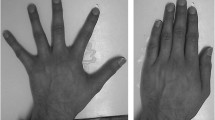Abstract.
Light touch of the index finger with a stationary surface at non-mechanically supportive force levels (<100 g) greatly attenuates the body sway of standing subjects. In three experiments, we evaluated the properties of finger contact and of the contacted object necessary to produce postural stabilization in subjects standing heel-to-toe with eyes closed, as well as how accurately hand position can be controlled. Experiment 1 involved finger contact with flexible filaments of different bending strengths, a flat surface, and an imagined spatial position. Contact with the flat surface was most effective in attenuating sway; the flexible filaments were much less effective but still significantly better than imagined contact. Experiment 2 compared the effectiveness of finger contact with a flexible filament, a rigid filament of the same diameter, a flat surface, and an imagined spatial position. The rigid filament and flat surface conditions were equally effective in attenuating body sway and were greatly superior to contact with the flexible filament, which was superior to imagined contact. Experiment 3 included five conditions: arms by sides; finger "contact" with an imagined spatial position; finger contact with a flat surface; finger contact with a flexible filament attempting to maintain it bent; and contact with the flexible filament attempting not to bend it. The arms by sides and finger "contact" with an imagined position conditions did not differ significantly; all three conditions involving actual finger contact showed significantly less center of pressure and hand sway, but contact with the flat surface was most effective in attenuating both postural and hand displacement. In all three experiments, the level of force applied in fingertip contact conditions was far below that necessary to provide mechanical stabilization. Our findings indicate that: (1) stimulation of a small number of receptors in the fingertip is adequate to allow stabilization of sway, (2) fingertip force levels as low as 5–10 g provide some stabilization, (3) contact with a stationary spatial referent is most effective, and (4) independent control of arm and torso occurs when finger contact is allowed.
Similar content being viewed by others
Author information
Authors and Affiliations
Additional information
Electronic Publication
Rights and permissions
About this article
Cite this article
Lackner, J.R., Rabin, E. & DiZio, P. Stabilization of posture by precision touch of the index finger with rigid and flexible filaments. Exp Brain Res 139, 454–464 (2001). https://doi.org/10.1007/s002210100775
Received:
Accepted:
Issue Date:
DOI: https://doi.org/10.1007/s002210100775




